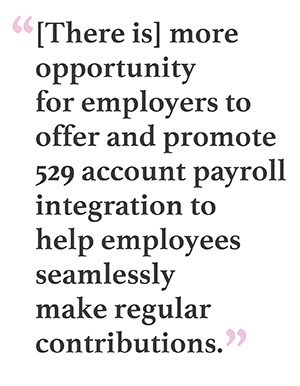 (Image: Shutterstock)
(Image: Shutterstock)
Changing financial and market landscapes are having an impact onindividuals' savings strategies, according to new research fromindependent benefit plan administrator Ascensus. For one thing, astuition expenses continue to rise, families are increasingly seeingthe value of investing in 529 education savings accounts, thecompany said Tuesday, citing the findings of its annual savings trendsresearch.
|Although the market downturn in 2018 had only a "minor impact onoverall 529 account balances across all demographics," the averagebalance reached almost $23,000 as of Dec. 31,Ascensus said in announcing its findings. "Another key trend tiedto this landscape of higher education expenses is the entrance ofolder generations of account owners into the 529 market," it said,noting that account owners ages 55 to 64, and those over 65—withaverage beneficiary ages of 17 and 13, respectively—had the second-and third-largest average balances of all age groups, bothexceeding $22,000.
|Saving trends are also being impacted by the fact thathealthcare expenses "continue to increase exponentially," Ascensussaid, noting the Employee Benefit Research Institute reported thatthe average couple will now cumulatively need $399,000 tohave a 90 percent chance of covering all their healthcare expensesin retirement.
| "Heightened awareness for thesestaggering costs and the increasing popularity of high-deductiblehealth plans have driven HSA [health savings account] enrollment to newhighs," the company said, adding there are now more than 25 millionhealth savings accounts held by U.S. savers, with acombined $53 billion in assets.
"Heightened awareness for thesestaggering costs and the increasing popularity of high-deductiblehealth plans have driven HSA [health savings account] enrollment to newhighs," the company said, adding there are now more than 25 millionhealth savings accounts held by U.S. savers, with acombined $53 billion in assets.
Ascensus' 401(k) platform data, meanwhile, showed that Americansunder 25 years old are saving at lower rates than those in olderage groups, which "suggests the need for further investigation intothe impact of competing financial priorities, including studentloan debt," according to the company.
|But there was a "notable, positive difference in progress forsavers" 25 to 34 years old: Of all retirement savers on theAscensus platform who said they're "on track" to meet their goals,20 percent are in that age range, compared with only 3 percent whoare under 25, the company pointed out.
|"We've seen a shift in the way that individuals across differentlife stages are saving for themselves and their families,"according to David Musto, Ascensus president. "To continue toaddress the savings deficit millions are facing, our industry needsto focus on offering tools and resources that make it quick,simple, and automatic for savers to track their progress," he saidin a statement, adding: "Employers, state governments, andfinancial advisors will continue to play an integral role inencouraging individuals to make the most of the savings vehiclesand tools available to them."
|The company analyzed data across a population of more than88,000 retirement plans, 4.6 million 529 college savings accounts,over 280,000 consumer-directed health care accounts, and 20Achieving a Better Life Experience (ABLE) plans for which itprovided recordkeeping and administrative services as of Dec. 31,it said.
|One takeaway from the research was that there's still "noone-size-fits-all approach to planning for what matters most,"Ascensus said.
|Among the other findings of the research was that plan sponsorsand savers see value in automatic savings models: 401(k) plansdesigned with automatic enrollment and automatic escalationfeatures saw an average plan-weighted participation rate of 81percent, 10 percentage points higher than that of plans withoutautomatic enrollment, the company said. In 2018, 35 percent of 529account owners had scheduled recurring bank contributions, and 20percent of ABLE accounts leveraged automatic savings methods. About6 percent of 529 account owners use a payroll direct deposit, butthere is "more opportunity for employers to offer and promote 529account payroll integration to help employees seamlessly makeregular contributions," it said.
|Meanwhile, digital tools are having a positive influence, itsaid, noting that its Retirement Outlook Tool enables savers torefine retirement savings goals, illustrating how their currentsavings levels may affect future readiness. In 2018, 26 percent offirst-time tool users were saving at an average rate of 8 percentwithin only a few weeks of engaging with it, the company said. That"suggests that access to the right planning tools can make apositive difference in getting employees closer to a savings rateof 9 percent or more, the minimum rate that 'financially prepared'savers have selected," it said.
||
From: ThinkAdvisor
Complete your profile to continue reading and get FREE access to Treasury & Risk, part of your ALM digital membership.
Your access to unlimited Treasury & Risk content isn’t changing.
Once you are an ALM digital member, you’ll receive:
- Critical Treasury & Risk information including in-depth analysis of treasury and finance best practices, case studies with corporate innovators, informative newsletters, educational webcasts and videos, and resources from industry leaders.
- Exclusive discounts on ALM and Treasury & Risk events.
- Access to other award-winning ALM websites including PropertyCasualty360.com and Law.com.
*May exclude premium content
Already have an account? Sign In
© 2024 ALM Global, LLC, All Rights Reserved. Request academic re-use from www.copyright.com. All other uses, submit a request to [email protected]. For more information visit Asset & Logo Licensing.








